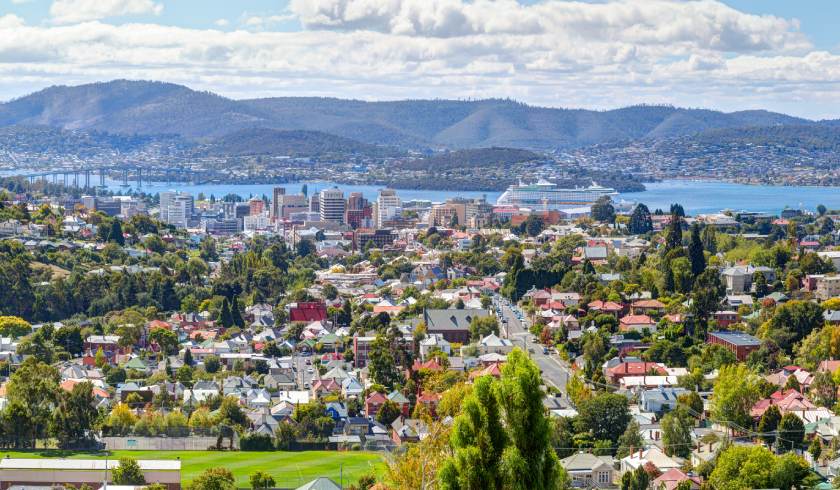Tassie property boosts balance sheet over latest quarter
Strong buyer and rental demand are continuing to drive prices and rents up across Tasmania, according to the latest data.

New figures from the Real Estate Institute of Tasmania (REIT) have shown that sales numbers across the state reached 2,956 in the three months to June 2021, with a record value of $1.459 billion.
Of the sales recorded over the quarter, 1,967 were houses, 373 were units and 570 were land.
It’s pushed up numbers over the year to date, with sale volumes up by 25.3 per cent, while cumulative sales value was up by 48.6 per cent or $952 million.
As such, the state government is poised to gain almost $100 million in additional stamp duty, building on the $1.5 billion it already gained through 2020.
Who are buying?
Despite the previous forecast that mainlanders were bound to dominate the local market due to a post-COVID-19 lifestyle shift, only 20.4 per cent of sales – or 584 sales – ended up being attributed to them over the quarter.
Of these mainland buyer sales, 365 bought property to move to Tasmania while the rest were investors. The median price paid by mainlanders was $486,000.
Even so, Ms Welling said the rise in demand from mainland buyers is likely to continue to accelerate as a result of the “growing popularity of Tasmania as a safe haven and lifestyle destination”.
First home buyer numbers remained stable at 14.5 per cent of all sales – acquiring 277 houses, 58 units and 95 lands – while investor numbers improved slightly to 19.2 per cent.
Foreign buyers, meanwhile, accounted for seven sales with a median price of $535,000.
Looking into the regions, Launceston recorded the most sales at 338 worth $161,558,244.
This was followed by Clarence with 295 sales worth $187,015,496; Hobart with 214 sales worth $192,762,932; Glenorchy with 207 sales worth $100,089,655; and Devonport with 164 sales worth $63,122,835.
Price hikes
With demand still strengthening across Tasmania, REIT president Mandy Welling said it may “continue to push prices and rents to record heights”.
Right now, Tasmania’s median house price sits at $510,000, while median unit and land prices are currently at $425,000 and $186,250, respectively.
Hobart, Launceston and the North West Centres have all recorded their highest median prices ever, with Hobart increasing by 26.2 per cent to $675,000, Launceston increasing by 22.6 per cent to $461,000, and the North West Centres increasing by 19.4 per cent to $382,000 over the year.
Sandy Bay ($1,411,000) and Acton Park ($1,084,625) remained the two most expensive suburbs in the state, while the most affordable were Rosebery ($129,850) and Zeehan ($150,000).
“A dire shortage of established homes for sale is failing to quell an insatiable appetite for property across all sectors of the market… If the current levels of activity continue for the remainder of 2021, insurmountable pressure will continue to be placed on property prices,” Ms Welling said.
She argued that stock shortages are at the heart of the issue – “without an increase in the number of properties for sale, the affordability gap will only widen”.
Illustrating that point, the state recorded $150 million sales over the quarter – a 172 per cent increase over just 12 months.
Rental market
Tasmania’s rental market also saw an increase in demand, resulting in rents hiking up to $10 to $25 a week across most regions.
Vacancy rates are now at a record low of below 2 per cent, with Hobart recording 1.4 per cent, Launceston 1.1 per cent and the North West 1.7 per cent.
But as rents fail to keep pace with rising property prices, rental yields have started to decrease, leading investors to claim diminishing returns and subsequently looking into other markets for better outcomes.
Hobart’s rental yields have declined to 3.7 per cent for three-bedroom homes, and 4.1 per cent for units, while Launceston has also dropped to 4.5 per cent for houses and 5.9 per cent for units. The North West, meanwhile, offers yields at 4.6 per cent for houses and 4.3 per cent for units
‘Insurmountable pressure’
Ms Welling has expressed concern around continuous increases to demand, which she said could place even more pressure on an “already overwhelmed market”.
As such, the president is calling on the government to expedite major private building and development projects in order to assist the market in meeting future demand.
She’s also encouraging stamp duty windfalls to be channeled into public housing to “help ease the burden currently carried by the private rental sector”.
Without this assistance, Tasmania’s immediate future could see “prices and rents having no other option than to continue to move upwards”, Ms Welling concluded.
